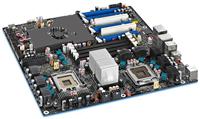Examining Intel's Skulltrail platform - and Skulltrail "on the cheap"

On Saturday an old friend got in touch with me. He's found himself (due to being unexpectedly made redundant) moving from being an amateur video editor into doing this for a living. He's now finding that he's getting more and more work in but that his current hardware platform is the weak link in the system.
"So, can you suggest something faster than my current dual-core system?" he asked.
"Easy, quad-core - Since you're using professional video editing software that can work with multiple cores you're going to see a huge improvement in going from two to four cores," I replied.
"Anything faster?"
"There are always Core 2 Extreme processors, if you're not allergic to spending money."
"I'm not allergic to spending money if it's going to produce results. Anything faster?
"Well," I said, "there's always Skulltrail ..."

Skulltrail is also mindbendingly expensive - the motherboard alone will set you back around $600 and a single QX9775 processor costs in the region of $1,600. So for a motherboard and two processors you're looking at spending $3,800. All you end up with for that price is a mobo and two CPUs. To transform these into an enthusiast-level PC you need memory, a PSU, graphics cards, hard drives, coolers ... oh and a case.
Now onto the next set of gotchas. If you're building a Skulltrail system you have to be careful to choose the right memory, PSU and case. The memory has to be the "fully-buffered" server sort and 800MHz FB DIMMs are hard to find and almost as pricey as DDR3. The D5400XS does support 667MHz RAM but that's introducing a compromise right off the bat.
Then there's the case. The D5400XS is an E-ATX form factor board, and that means finding a case that's compatible. Forget midi cases, this board needs a full tower.
Altogether I think that you'd be lucky to get change from $6,000 for a build-your-own Skulltrail system.
"Skulltrail" - On the cheap ...
Now spending $6,000 on a Skulltrail system shouldn't be done lightly. My friend didn't seem that phased by the cost but if you're in a position where your PC is earning you money, and remembering that time is money, then it's not too bad. He's using professional video software which means that he's going to see the benefits from having a system with eight cores.
But what if you want an eight-core system just for bragging rights and you don't have (or want to spend) $6,000? This is what I was left thinking about after I sent my friend on his way to think about whether he wants to spend $6K on a system.
Sure, there's a performance hit since the E5410 runs at only 2.33GHz compared to the 3.2GHz of the QX9775 but it's not as much as you'd expect. Eight cores running at 2.33GHz is still a lot of power.
Having made this tweak to the spec you can expect to build a really amazing dual quad-core system for around $3,000.
But this tweak still leaves you with an expensive motherboard and PSU. If overclocking isn't your thing then you can get rid of the Intel D5400XS motherboard and instead use a standard Xeon board - such as a Tyan - and save more money because you can use a more sensible PSU. You lose along with overclocking the ability to have SLI/CrossfireX but there are plenty of powerful single-card GPU solutions out there.
It's important to note that these systems aren't actually Skulltrail systems, at best they're "Skulltrailesque" but they do show what's possible if you start to think outside the box. They also show that dual-quad-core systems are slowly edging closer to being the new quad-core systems for enthusiasts. Sure, you have to spend a lot of dough, but you get a very good system at the end.
Thoughts?
<< Home >>